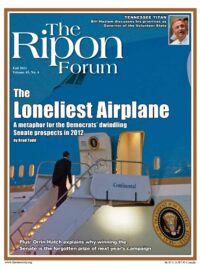 In 1969, the commentator Kevin Phillips wrote a book called “The Emerging Republican Majority,” in which he essentially argued that the United States was entering a period of transformation, one that would not only see the pendulum swing from the left side of the political spectrum to the right, but one that would last for decades to come.
In 1969, the commentator Kevin Phillips wrote a book called “The Emerging Republican Majority,” in which he essentially argued that the United States was entering a period of transformation, one that would not only see the pendulum swing from the left side of the political spectrum to the right, but one that would last for decades to come.
If Phillips were to write a sequel to his book today, he would no doubt have to reconsider the period of time in which the American electorate undergoes a political shift. For if the last few elections are any indication, that period is shorter than it has ever been before. In fact, one could argue that political transformations in America no longer last for decades, but rather last no more than a handful of years.
Consider the following: In 2006, Democrats gained a net of 30 House seats and won the popular vote among the 81 million House voters by a margin of 52-44 percent. Then, two years later, they gained another 21 House seats and, out of the 123 million House voters, won the popular vote by a margin of 53-42 percent. However, in spite of all the talk in early 2009 about a new Democratic majority and very rosy poll numbers at the time, the next year would see a crushing collapse in Democrat fortunes.
Republicans dominated the mid-term elections in 2010, gaining 63 seats in the House of Representatives and winning the votes of the 87 million Americans who supported the GOP candidate over the Democratic candidate by a margin of 51-45 percent. As we look toward the 2012 elections, we need to ask ourselves not just whether this accelerated cycle will continue, but what the trends of next year’s campaign will be.
A Volatile Electorate
The first trend has to be volatility. In our own generic polling among likely voters for the House, over the last cycle we saw the Democrats lose their 42 percent – 31 percent lead over the Republicans in January 2009; to a Republican lead 40 percent – 38 percent in September 2009; to a commanding Republican lead of 51 percent – 37 percent in September 2010, and ultimately the Republican victory.
Currently our most recent national poll of likely 2012 voters shows that Republicans have a slight 41 percent – 37 percent generic lead, but a large and volatile 22 percent are undecided. Is there a second consistent trend? For the third election in a row, the incumbent President was a negative factor with regard to the reelection of his own party’s House members. There are no signs yet that President Obama will be anything but an election millstone for most Democrats.
As we look toward the 2012 elections, we need to ask ourselves not just whether this accelerated cycle will continue, but what the trends of next year’s campaign will be. The first trend has to be volatility.
Indeed, the President’s decline in job approval and favorability from 70+ percent positive ratings in January of 2009 had become an upside down rating later that same year and a 45 percent positive to a 53 percent negative job approval by November, 2010. At this time the current Real Clear Politics poll average has the President wallowing in a similar upside down rating of 45 percent approve to 51 percent disapprove.
Now, the President is trying to improve his ratings by running against a less popular Congress. But most voters still like their incumbent member, and blame the other party for Congressional failure. As a consequence, it is little wonder that in the House special elections this past September in Nevada’s 2nd and New York’s 9th Congressional Districts, the President was such a liability that he never campaigned with either Democratic candidate. The numbers tell the story as to why. In Nevada, 6 in 10 voters disapproved of the job the President was doing. In New York, 59 percent disapproved.
Although the President is trying to project blame on Congress, his own continued failure will be a major factor in favor of the election of House Republicans next year.
In both September special elections, 2 in 3 voters said that since Barack Obama became President, they and their families are not better off than they were two years ago. These voters — although many were Democrats — voted Republican. The President is badly in need of a tangible policy success that makes voters feel better about their circumstances. However, even the President’s own advisors are predicting slow economic growth at best.
Although the President is trying to project blame on Congress, his own continued failure will be a major factor in favor of the election of House
Republicans next year.
Tactically, the Democrats see opportunity in the 62 districts currently held by Republicans that Barack Obama won in 2008. Still, in 37 of these seats, Republican margins exceeded the President’s edge, and now the President is much less popular than he was three years ago. Nevertheless, Democrats will do their best to win those seats in battleground presidential states, whose electoral votes will be critical to Obama’s re-election.
As a result, House seats in Pennsylvania, New Hampshire, Indiana, Wisconsin, Ohio, Michigan, Missouri, Iowa, Virginia, North Carolina, Florida, New Mexico, Arizona, Colorado, and Nevada will feel the extra push of Democratic resources for new registrations and early or absentee voting. The difference now is that all these states have large pockets of independent, undecided or unregistered voters who now disapprove of or view unfavorably the President and his Democratic allies in Congress. These voters must be identified and mobilized to vote Republican.
Additionally Republican midterm gains also secured their ability to protect or gain new Members through redistricting.
Already experts are forecasting that in spite of the recession, campaign spending for television, mailings, and new media will reach record amounts – possibly topping $3 billion alone just for television. Presidential election spending rose 30 percent in 2008, and mid-term TV ad spending rose 30 percent, as well.
Issues of Concern
Regarding the voters’ issue agenda, insecurity among the voters has extended from economics to national security. The national issue agenda, dominated thus far by concerns about creating jobs, cutting government spending and reducing the national debt, may be about to expand to national security issues, as well.
In fact, recent polling indicates that a growing number of Americans have concerns over national security. In national surveys we did for SecureAmericaNow.org two-thirds of voters believe that national security will be very important in 2012. To that end, most Americans cite external threats to our country as one of their top concerns at levels not seen since the Cold War, with Iran, China and North Korea viewed as threats to our nation’s security by most Americans.
The national issue agenda, dominated thus far by concerns about creating jobs, cutting government spending and reducing the national debt, may be about to expand to national security issues, as well.
Of very current concern, just over 3 in 4 voters – or 78 percent — say that President Obama’s policies will fail to stop Iran from getting nuclear weapons, and 80 percent believe that Iran would arm terrorists to use nuclear weapons to attack the United States. Moreover, 86 percent of Americans are concerned about Islamic terrorism by American born Muslims. The bottom line is that next year’s election may end up turning on more than just jobs and the economy.
In this volatile political environment and with 3 in 4 voters saying that the country is on the wrong track, we will continue to see a growing number of House candidates running as outsiders — outsiders who are not experienced in the ways of Washington, but are closer to the people of one’s district.
Will this volatility be enough to unseat the House Republican majority? Given the unpopularity of the President the GOP advantage in Districts he carried in 2008, the betting here is that it will not.
But if recent years have proven anything, it is to expected the unexpected and understand that no incumbent is safe. RF
___________________________________
John McLaughlin is the CEO/Partner of McLaughlin & Associates.




